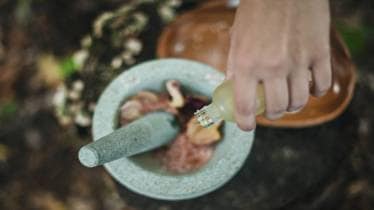Ayurveda has an age-old tradition, having originated in India perhaps as much as 3,000 years ago. Today it remains a favoured method of health and wellness in multiple parts of the Eastern world and India, where a massive percentage of the population uses this system exclusively or combined with modern medicine.
Ayurveda translates to knowledge of life and is based on the idea that any disease in our body is often due to a known or unknown imbalance or stress in a person’s consciousness state. Ayurveda encourages natural therapies and lifestyle interventions to maintain a balance between the body, mind, spirit, and the environment. Sana Mir, a dietitian at Chicnutrix, shares some remedies you should try this winter to boost your immunity.
Saffron Tea
Saffron is one of the important spices from the vale of Kashmir. It has numerous benefits because it not only acts as an antioxidant but improves mood & treats depressive symptoms. It reduces PMS symptoms, reduces heart diseases and regulates blood sugar levels, to name a few. So this winter, ditch your everyday green tea and try saffron tea instead.
Garlic
Raw garlic is one of the most ancient used spices in ayurveda. It is an anti-aging spice that is hot in nature and used to cleanse the digestive tract. It is good for the eyes, prevents cough and cold, asthma, and has multiple benefits.
The rasa (Taste) of garlic is predominantly pungent, but varieties of it are also sweet, salty, and bitter. During winters, garlic powder is mainly recommended to balance out the kapha dosha (Kapha dosha is the Ayurvedic mind-body element associated with earth and water). Garlic has evidently also been shown to help cure skin diseases, especially during winter for those who face problems like flaky and dry skin. The recommended dosage of garlic powder is around 1-2 tsp per day, and that of garlic oil is 1-2ml in single or multiple doses per day.
Amla
Amla also known as Amalaki is said to be the most used ayurvedic ingredient in ayurveda. It is categorized as a fruit in modern science and medicine in ayurveda. If you have vata imbalance (Flatulence/gases, joint pain), then one teaspoon of Amalaki powder can be taken along with a teaspoon of gingelly oil (Sesame oil). Studies have proven that Vata is more dominant during the evening; hence it is advisable to take the dosage of amla and gingelly oil in the evening. Traditionally, amla also acts as a home remedy to cure acne, scars and reduce hair fall in winter since our skin and head scalp are prone to dry quickly.
Turmeric
In ayurvedic practices, turmeric is popular due to its many medicinal properties, including strengthening the body’s overall energy, relieving gas, dispelling worms, improving digestion, regulating menstruation, dissolving gallstones, and reducing arthritis. The anti-bacterial, anti-viral and anti-fungal properties of turmeric protect you from various health concerns like colds, flu, cough, acne, and dry and cracked skin and boost our immune system due to its functional property of curcumin present in it.
Triphala
Triphala is classified as a tridoshic rasayana, meaning that the energetics are appropriate for Vata, Pitta, and Kapha or all types of patients. The rasa (taste) of Triphala is sweet, sour, pungent, bitter, and salty. In Ayurveda, Triphala is mainly used for gastrointestinal treatment, to reduce gut inflammation, increase appetite, reduce cholesterol levels, etc. It also helps in increasing haemoglobin levels. It is a powerful and rejuvenating herb that can be used for consumption and external application and is proven as a therapeutic treatment for multiple pathologies.
Try these ayurvedic remedies this winter and elevate your overall health with Ayurveda.
